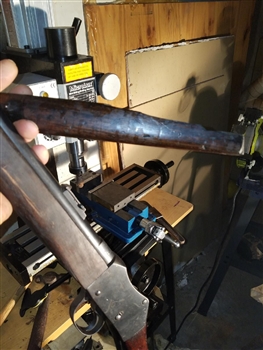My me time
Machining a new wood forend for an 1877 Martini Henry Mk II artillery carbine to replace a rotted forend on an MH carbine from the Royal Arsenal of Nepal is how I spend my time today.The Martini Henry was the British military rifle for much of the 19th century until replaced by the Lee rifle. MH Mks, I through IV used a black powder cartridge called the .577-450. These guns saw service anyplace there were British soldiers. The Kingdom of Nepal had a brief skirmish with the British East Indies Company. In the truce and peace talks that followed England agreed to arm the Army of Nepal with British weapons. This they did, with every old weapon they had laying around. Brown Bess flintlocks, halbreds, swords, Snider rifles, even matchlocks. Then as new versions of the Martini Henry were developed the older ones were pulled from service and sent to Nepal. Gardner and Gatling guns followed as did older bronze artillery pieces. Anything old weapon, regardless of condition, went to Nepal. This continued until the early 1900s when King George visited his ally and counterpart and was horrified to learn they had not yet received any new Lee rifles or machine guns. He ordered they be sent to them and that Nepal should get all of the new weapons of the English army. So Nepal's army was soon modernized in time for WWI. Gurkha troops were supplied to England and their performance on the battlefield became legendary. Nepal was then armed again with more modern weapons for WWII. The US supplied weapons too. After WWII and the English pullback from India Nepal found other additional sources of modern weapons.
The Kingdom of Nepal was a very frugal nation and they felt just because they had a newer gun, cannon or sword, that was no reason to melt down the old ones. So they had this old 17th century palace no one used anymore after a newer palace was built. In the 1880s a decision was made that all of the old weapons should be stored in the old palace and old stables and the property re designated as the Royal Arsenal. As new weapons and ammunition came in from the British the older weapons were rotated out, dipped in melted Yak grease to preserve them, then lain on the floor somewhere in the old palace. The facility was guarded, but not really maintained by Western standards. The roof began to leak, but no one repaired the leaks. The windows were without glass. In some cases boards were placed to keep out rain, but not at every window and as shutters damaged over the century, they weren't replaced. There was no effort made to segregate or even index what was stored. A pile of Brown Bess rifles may be found to have a Napoleon 12 pounder cannon at it's core while another pile of rifles was found be stacked over some Vickers Machine guns mixed with swords covering 200 years of issue. Matchlock rifles under chain mail shirts and 15th century helmets next to Gatling guns. Sometime after WW2 the palace and stable grounds were full, and although guarded the facility became forgotten and mostly ignored.
The entire Royal family of Nepal was assassinated in 2002 and their Prime Minister then seized the throne. This then plunged the country into a nasty multi sided civil war of several years duration (mostly utterly ignored by American media) before India and China jointly invaded from opposite sides and together forced a cease fire and peace. During a break in the fighting an American antique company owner happened to be visiting Nepal and heard of an old palace full of military antiques. He made a sight unseen monetary offer to purchase all the old weapons to whoever was ruling the capital that month and the offer was accepted.
Then began the problem of getting the things out of Nepal and back to the United States.


Comments (11)
Once Again , Good Blog, Thanks Bud
When I was a student, I didn't like history lesson. It always kept talking about too looong-dead people and about years. I was just lucky to pass the test.
You, on the other hand, seem to loooovvee history.
Anyways, hope your boy and girl are well.
A very interesting blog!
I am currently fabricating a slip-on fiber optic front sight to be used with a removable peep sight I have made for the carbine. The adding of both will not alter the carbine from it's original configuration but will IMO greatly increase the capabilities of the gun in twilight or dark woods. Last year the tiny factory front sight proved almost useless in the woods as sundown approached.
Just commented on your blog about the female bail bonds person shooting that guy...scary stuff...
Post pics of your cats too...
Cheers
My 1887 type 3.
Made by Wilkinson of course.
The Cavalry variant of the MH carbine used no bayonet as the riders also had 1890 cavalry sabers.
The artillery version of the MH carbine had a much longer (25.75" blade) Model 1879 bayonet with a cutlass type hand guard and a saw back. The saw back allowed the blade to also function as a wood cutting saw when needed to clear trees for the artillery or similar purpose. In this country those are very rare and pricey, Atlanta Cutlery sells a $150 reproduction. Real ones pictured here.
The earlier versions of the MH rifle (Mk I, Mk II, and Mk III) used a triangular spike bayonet.
1887 type 3 bayonet for the MK IV MH and Martini Enfield (ME) rifles